Professor – Group A: Ramón Cedeño
Planet Drum Foundation
Bioregional Education Program
Final Reports-English
(Click here for Spanish/Español)
photos below.
2010

At this stage, we were visited by William and Jaime, two volunteers who participated in the last three bioregional education programs. The first thing I did was present them, one at a time, to the group of bio-regional explorers.
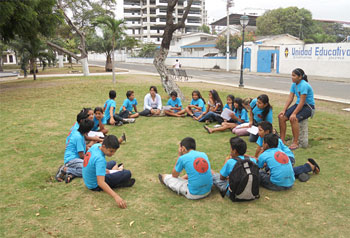
Afterwards we started class with a new topic: the estuary. The groups were directed by Raisa, Lissette, William and Jaime, and another by me. Each group had to analyze the themes so we could form a large circle and share what each group learned about the topic.
One of the kids told me that he didn’t understand the volunteers well when they spoke quickly, though the students did understand when they began to speak slower. It was a good experience for them. After having done the exercise, we made a big circle and Ingrid told us that the estuaries are very important because mangroves grow there and Luis Cuellar told us that the estuary is a big valley where the Rio Chone flows and that many marine species come to spawn there.
Jennifer told us that people contaminate the estuary and we do not know what types of contaminates might be in the estuary. I told her that it’s true that at times we don’t know if there are contaminants, since the rivers pass through many populated areas, and farmers (among others) carry out activities that are harmful to the estuary. Noemí talked to us about the water cycle and how she realizes the importance in respecting human life.
After we finished the job, I told them that the estuary is very important and that the mangroves here can be a habitat for many species. However, residues from the local water system have been directed into the estuary since the water system collapsed many years ago. I also told them about the impact of erosion in creating large deposits inside this ecosystem.
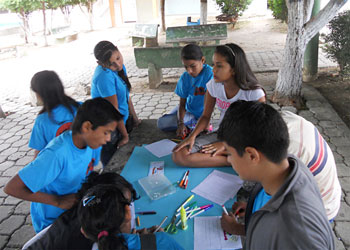
Friday we switched to another activity. I told the kids that we were going to walk to the boardwalk strip of the city and clean the beach. So the children formed groups and began to clean the beach (with bags and some with gloves). We saw the enormous amount of trash there, especially plastic garbage and Ingrid Melo and her group collected the trash and said that the area looked clean but if one looks closely there is (still) garbage.
Carlos found the backbone of an eel and he wanted to know what had happened to the eel, so I told him that the birds feed off of eels and that the birds also contribute to cleaning the ecosystem. Carlos also asked what type of bird eats eel, to which I told him it was the red-headed vultures that we always see on the beach or flying nearby.
After filling three bags of plastic trash I told them that today we have helped, perhaps, many animals that could have confused the garbage for food.
As we finished the job, the kids played frisbee and on the beach we met a friend who invited us to play and the kids were delighted by the invitation. They ran around on the beach until everyone had to go to home.
When we began the Topic of Flora, we used the same technique as last week: forming groups and asking the children why flora is important and “what is flora”? As the children analyzed the topic they answered that all of the plants are flora.
To this I responded that, yes plants are very important and that they in addition to providing a habitat, they also provide oxygen for other species, especially important, e.g. for the human species.
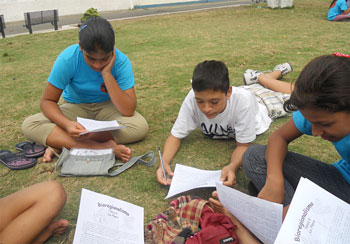
Luis Cuellar said that many species can live there, such as birds which can make their homes there. Noemí said that flora can provide food to humans just as it does for animals, like fruit trees.
After this, I told them they were right because today we have only a few of the original tree species because of deforestation. And this has caused a big problem, called erosion, which is progressively washing away the top soil.
Here there are many species of trees, and I asked how many trees there are in the dry forest. They began to name many such as the Ceibo, Bototillo, Algarrobo, Guayacán, Palo Santo, and many others. I told them that Friday we would go on an fieldtrip to one of Planet Drum’s revegetation sites and we could observe plants that were planted this year.
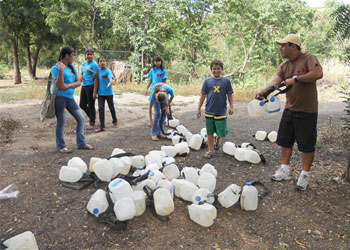
The day of the field trip to the site of reforestation at Kilometer 8, where William Sánchez is, we picked up several empty plastic jugs along the way to the site. We travelled on the bus with Clay and arrived at the site quickly. Once there, we headed for the water cistern since our activity was to water the trees. Before we started, I told the group that they could see the different species of trees planted by the Foundation at this site.

Clay told us that each gallon of water could be used to plant three trees. From there Clay directed us to a place where the kids began to water the trees, some in one spot and others at another. On our first trip, my group ended up at a dead end but when we went back another way we saw many trees that were planted, so then we took two more trips. The kids ran down the trails. Later on, the students played with the water that was leftover. After all our work was done, Clay bought a couple of gallons of drinking water for the children.
This week the topic was Birds. We discussed the importance of birds in our environment, since birds are the propagators of many plant species. I asked them if all the birds fly, and they said yes, to which I said “no,” because there are species that do not fly like an ostrich. Then everyone started to laugh. After that I talked about the many different types of bird feathers such as wing feathers, tail feathers and down, which are very important to direct flight and provide a protective shield.
Many of them migrate, for food or to mate, and there are many species, raptors, waders, etc. I asked why the wading species were web-footed and no one knew. I told them that this membrane in their feet serves as legs for swimming. A major threat is habitat destruction, to which Luis Cuellar said, “By cutting down trees?” I answered yes.
The trip to Isla Corazon is one of the most eagerly anticipated trips. All the students in Bahia waited for the car ferry and the rest waited in San Vicente due to the large number of students. We rented a bus to get around faster. Once the bus stopped, the kids went to the store and started to buy things and I realized they generate more income in this community.
Click here to see photos of the trip to Isla Corozon
After that, we boarded the boat to start the tour. Our guide described each bird species. During this period between the months of July and August the frigates are in mating season, so we got to observe the frigates with their characteristic chest, a very beautiful red color. Also, they taught the children the difference between female and young male frigates. There were other many types of birds such as pelicans, and different types of herons.
We talked about the depth of the estuary. Historically it was 30 to 40 meters and now it’s only 5 caused by the sedimentation deposits from deforestation.
We then entered the mangrove tunnels of Isla Corazaon, where the guide taught the students about the seeds of the red mangrove. Our guide also told the students that it is said that the tallest mangroves in Ecuador grew in Esmeraldas. He also told us that in this estuary there were some mangroves that measured 70 meters in height prior to the destruction of the mangroves as part of the shrimp farm industry. The guide said when he worked in the shrimp farm industry he participated in cutting down all these trees and now feels very sorry for what he did. As a result, he is now working on conservation and is aware of the effects from the cutting of trees he did. After that we talked about the tannin that was extracted from the mangroves and used to tan leather.
We also saw termite nests and observed the negative impacts of human beings due to plastics waste. After finishing the tour we all returned to our respective neighborhoods. The kids from San Vicente stayed there while the others got ready to board the barge to return to Bahia. That week we analyzed the marine ecosystem and talked a bit about our tour of Isla Corazon. I asked the kids, “What is the difference between winter and summer in our bioregion.”
Luis Cuellar said that in winter it is cold and summer it’s hot. Ingrid said that the forest changes color as the leaves fall. Naomí said it rains a lot in winter. I told them that all the responses were correct. And I said that our coastline is influenced by the cold Humboldt Current and warmth of El Niño. These factors allow us to have a vast array of fish and the ocean is a large ecosystem that provides us with nourishment and contributes to the water cycle. We also talked about humans’ impacts on the region from the overexploitation caused by fisheries, contaminants that are deposited into the sea, such as pollutants that are washed down from the watersheds by the rain.
A large number of species live and survive on the sea, like pelicans, blue footed boobies, frigates and other species we saw in these ecosystems. When we made the trip to Punta Bellaca, the tide was rising but we saw a lot of shellfish, crabs, crabs, many echinoderms such as sea urchins. In tidepools there were animals such as asteroid starfish, sea cucumber, and fish. But after reaching Punto Bellaca, the young explorers saw the large amount of plastic waste in the ocean, and I told them the negative impacts of human beings. Jennifer said that other marine species mistake them for food.
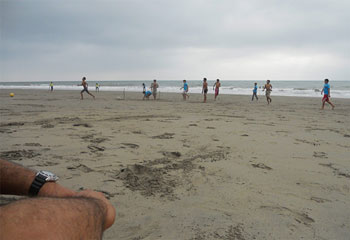
Once we finished the tour, the boys swam and played soccer on the beach until the trucks came to pick us up.
The week of evaluation was the last class .The boys and girls were amazing. They could identify a bioregion with its characteristics, the importance of the environment around us and our relationship with them directly.
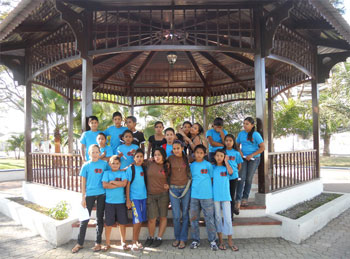
On Friday, we were provided a barbecue and closing ceremony for the kids. Click here for pictures from the Closing Ceremony. And after lunch we made a circle so that the scouts could talk about what they learned. Naomí thanked Planet Drum for allowing her to participate in the program. She also mentioned the importance of water and talked about how she previously wasted more water. Ingrid Cuellar and Luis Melo also made their presentation on how the bio-region was composed and of how they could produce compost. After the presentations, we took all the kids to the beach to go swimming.
Translated by Clay Plager-Unger
Profesor – Grupo A: Ramón Cedeño
Fundación Planet Drum
Programa Educativa de Bioregionalismo
Informes Finales – Spanish/Español
2010
En esta etapa, hemos tenido la visita de dos voluntarios que por tres años seguidos han estado participando en el programa de educación bioregional, ellos son William y Jaime.
Lo primero que hice fue presentarles al grupo de exploradores bioregional, los chicos se fueron presentando uno a uno.
Después de esto dimos inicio a la clase, con un nuevo tópico, el estuario, donde hicimos grupos de trabajo, dirigidos por Raisa, Lissette, William y Jaime, y otro por mí, donde cada grupo tenia que analizar los temas para después formar un gran circulo y exponer todo lo que entendieron sobre el tema.
Unos chicos me decían que no podían entender muy bien a los voluntarios cuando hablaba rápido, pero cuando empezaron a hablar mas lento le entendieron, fue una buena experiencia para ellos
Después de haber hecho el trabajo hicimos un gran circulo y Ingrid nos dijo que los estuarios son muy importantes por que pueden crecer muchas variedades de manglares, Luis Cuellar nos dijo que el estuario es una gran cuenca donde desemboca el Río Chone, y carrizal y que ahí pueden venir a desovar muchas especies marinas.
Jennifer nos dijo que en el estuario que hay personas que lo contaminan y que nosotros no sabemos que tipos de contaminantes puede tener o no el estuario, a lo que le dije que si que a veces no sabemos si hay contaminantes, ya que los ríos pasan por muchos lugares poblados, agrícolas entre otros y ellos realizan actividades perjudiciales para el estuario, Noemí nos hablo sobre el ciclo del agua y como ella ahora se da cuenta de la importancia del agua en la vida de los seres vivos.
Después de haber realizado el trabajo les dije que el estuario es muy importante ya que aquí los manglares pueden ser hábitat de muchas especies, pero que hace muchos años el sistema de agua servidas de la ciudad colapso, y todas estas aguas residuales se dirigieron al estuario, a si mismo les dije sobre el impacto que cusan las personas en el ya que por la erosión se esta creando una gran sedimentación dentro de el.
El día viernes nos dirigimos a realizar una actividad diferente, ese día les dije a los chicos que hoy caminaríamos por el malecón de la ciudad y limpiaríamos la playa, es así que los jóvenes formaron grupos y con sacos y unos con guantes, empezamos a limpiar la playa y vimos la gran cantidad de basura que había, especialmente plásticos, Ingrid Melo y su grupo recogían y decía que parece que esta limpio el lugar pero si miramos bien hay muchos desechos.
Carlos Panta encontró la espina dorsal de una anguila y me dijo que paso con ella a lo que respondí que eran las aves quienes se habían alimentado de ella y que ellas también realizan un trabajo de limpieza, me pregunto que tipo de ave a lo que le respondí que era el Gallinazo cabeza roja, y que nosotros lo habíamos visto siempre cuando vuelan o están en la playa.
Después de haber llenado tres sacos de basura plástica les dije que hoy tal vez hemos ayudado a muchos animales que hubieran confundido estos como alimentos.
Una vez terminado el trabajo los chicos jugaron frisbee, ya que en la playa se encontramos a un amigo que nos invito a jugar y los chicos encantados corrían el la playa hasta que tuvimos que salir cada uno a su casa.
Cuando realizamos el tema Flora, realizamos la misma técnica que la semana anterior, formando grupos y empecé a preguntar a los chicos por que es importante la flora o que es la flora, y como ellos habían analizado ya el tema respondieron que son todas las plantas.
A lo que le respondí que si y que ellas son muy importantes ya que a mas de servir como hábitat, para otras especies nos brindan oxigeno muy importante para la vida de los seres vivos.
Luis Cuellar dijo que ahí pueden vivir muchas especies, ya que las aves pueden realizar sus casas ahí, Noemí dijo que nos pueden brindar alimentos tanto a los seres humanos como animales, como los árboles frutales.
Después de esto les dije que tenían razón pero que ahora ya no hay muchas especies de árboles por la deforestación que ha habido, y esto a creado un gran problema llamado erosión que es el desgaste progresivo de la capa del suelo.
Que aquí hay muchas especies de árboles, y pregunte cuantos árboles hay en el bosque seco, empezaron a nombrar muchos como, ceibo, Bototillo, algarrobo, guayacán, palo santo y otros mas.
Les dije que el día viernes haríamos un recorrido, a un sitio de reforestación de la fundación y podríamos observar las plantas que se sembraron este año.
El día del recorrido al sitio de reforestación queda en el Km. 8, donde William Sánchez, llegaron muchos galones vacíos que los utilizaríamos en nuestro recorrido, ese día salimos en un bus con Clay y Sol, cuando arribamos al lugar rápidamente nos dirigimos a la cisterna ya que la actividad que realizaríamos era regar los árboles, es un sitio muy grande, antes de empezar les dije que aquí hay especies que ha sido sembradas por la fundación, y Clay les dijo que cada galón sirve para tres plantas, es así que Clay nos dirigió al lugar y los chicos empezaron a regar los árboles, unos por un lugar otros por otro lado que cuando hicimos el primer recorrido nos encontramos en el final pero cuando regresábamos por otro camino vimos una gran cantidad de árboles que habían por otros senderos es así que hicimos dos viajes mas, y los chicos corrían por los senderos y los galones de agua que sobraron se empezaron a bañar, después de haber terminado el trabajo Clay compró unos galones de agua para los chicos.
La semana que vimos el tema las aves, hablamos sobre la importancia de esta en la vida, ya que ellas son las que propagan especies vegetales, y les pregunte que si todas las aves vuelan, y me respondieron que si, a lo que le respondí que no ya que hay especies que no vuelan como la avestruz, y todos empezaron a reír, después de esto les hablé que las aves tienen muchos tipos de plumas como remeras, tectrices, timoneras y plumón, que son de mucha importancia para dirigir el vuelo y cubrirlas, que muchas de ellas realizan migración, sea por alimento o para aparearse, y que hay muchas especies como rapaces, corredoras, zancudas, palmípedas y muchas más. A esta última les pregunté por que eran palmípedas y ellos no supieron responder. A lo que le dije que es porque tienen una membrana en sus patas que le sirven para poder nadar.
También les explique que una de las principales amenazas es la destrucción de su hábitat, a lo que Luis Cuellar dijo que por la tala de árboles, y lo que respondí afirmativamente.
Este recorrido es uno de los más esperado por todos los chicos a “ISLA CORAZON”, todos los que estábamos en bahía, esperamos la gabarra, por la gran cantidad de alumnos que transportamos, otra cantidad nos esperaron en san Vicente, ahí nos estaba esperando un bus que alquilamos para poder movilizarnos más rápido, en el viaje los chicos exploradores siempre con sus locuras por ser hiperactivos, pero muy inteligentes, una vez que estábamos en el lugar los primeros en correr fueron los del grupo A, fueron a la tienda y empezaron a comprar y otra vez me di cuenta como ellos generan más ingresos en esta comunidad, esto no fue del agrado para ciertas personas, pero yo siempre estoy feliz con el desempeño de mi grupo, es así que partieron los del “ C “, y los chicos estaban un poco enojados es si que yo les dije que se tranquilizaran que no paso nada, y hice un circulo y les pregunte que habíamos aprendido el día miércoles, que especies de animales y árboles habitan aquí.
Después de esto nos embarcamos al bote para iniciar el recorrido, con nuestro guía, dónde él les fue detallando cada una de las especies de aves que hay en el lugar, ya que en esta época entre los meses, de julio y agosto las fragatas están en época de apareamiento, y observamos la gran cantidad de esta especie con su pecho característico, color rojo muy hermoso, además de que les enseño a diferenciar entre las hembras y machos jóvenes de fragatas, habían muchos tipos de aves como pelícanos, diferentes tipos de garzas.
Nos hablo sobre la profundidad del estuario antes que era de 30 a 40 metros y que ahora solo es de 5 como ingresaban los delfines, y que ahora por la deforestación el estuario tiene mucha sedimentación.
Terminado el primer recorrido ingresamos al sendero de la isla corazón, donde los primero que le enseñaron a los chicos es el propagulo, la semilla del mangle rojo, y nuestro guía también le contó que dicen que en esmeralda están los mangles más altos del ecuador y nos contó su historia que los manglares más alto estaban aquí en este estuario y que median más de 70 metros de alturas y cuando él trabajaba en camaroneras el tumbo o talo todos estos árboles y que ahora siente mucha pena por la que hizo, y que ahora el está trabajando en conservación y se dio cuenta de todo lo que hizo.
Después de ello nos hablo sobre el tanino que sacaban antes del manglar y que era utilizado para curtir cuero.
Los chicos tenían miedo ingresar por la historia de el duende que vive en el lugar, también vimos casas de termitas adema de los impactos negativos del ser humano como plásticos, después de terminar el recorrido todos regresamos a nuestro respectivo lugar los chicos de san Vicente se quedaron haya, mientras nosotros nos aprestamos a subir a la gabarra para regresar hasta bahía.
La semana que analizamos ecosistemas marinos hablamos un poco sobre nuestro recorrido en la isla corazón, por que forma parte de este ecosistema, inicie realizando una pregunta, cual es la diferencia entre el invierno y verano en nuestra bioregión.
Luis Cuellar dijo que en invierno hace calor y verano frio, Ingrid dijo que el bosque cambia de color ya que empiezan a salir sus hojas, Noemí dijo que llueve mucho en invierno, y les dije que todas las respuestas eran acertadas.
Y les dije que nuestra costa como saben ellos están influenciadas, por la corriente fría de Humboldt y cálida de el niño y por eso poseemos una riqueza ictiológica, muy grande, que el mar es una gran despensa ya que el nos brida alimentos, por su gran inmensidad se puede realizar el ciclo del agua.
Pero que el hombre también a creado grandes impactos, por la sobre explotación de la pesca, contaminantes que son depositados al mar, y que por la lluvia todas las cuencas hidrográficas depositan contaminación.
Que una gran cantidad de especies viven y subsisten con el mar, como pelícanos, piqueros patas azules, fragatas y demás especies que conocemos que hay en este tipo de ecosistemas.
Cuando realizamos el recorrido hacia punta bellaca, la marea estaba subiendo pero logramos observar una gran cantidad de crustáceos, jaibas, cangrejos, muchos equinodermos, como erizos que se encontraban en posas de agua, asteroideos como las estrellas de mar, pepino de mar, y que ellos respiran por branquias.
Pero después de esto cuando atábamos llegando a punta bellaca los jóvenes exploradores miraron la gran cantidad de residuos plásticos que estaban en la orilla del mar, y les dije que son los impactos negativos de los seres humanos, Jennifer dijo que ellos pueden ser confundidos como alimentos por otras especies marinas que las confunden con alimentos.
Una ves terminado el recorrido los chicos se bañaron y jugaron fútbol, en la playa hasta que llegaron los vehículos a recogernos y cada una retirarse a su hogar.
La semana de evaluación fue la última clase en el parque los resultados de muchos chicos y chicas fue sorprendente, podían identificar una bioregión con sus características, la importancia del medio ambiente en nuestro entorno la relación que tenemos directamente con ellos.
La elaboración de compost, la diferencia entre una especie endémica y introducida.
El día viernes se les brindo una parrillada como clausura, jugué con los chicos fútbol Raisa, Nadine, y los chicos de los diferentes grupos, se bañaron y después de comer hicimos un circulo para que los exploradores hablaran sobre lo que aprendieron, Noemí agradeció a la fundación por que les permitió estar ahí y sobre la importancia del agua y como ella antes la desperdiciaba, Luis Cuellar e Ingrid Melo también hicieron su presentación de cómo estaba constituida la bioregión de cómo podían elaborar compost.
Después de esto los chicos se retiraron y nosotros recogimos todo lo que se llevo a la playa, para después disfrutar de un baño en la playa.

Your point of view caught my eye and was very interesting. Thanks. I have a question for you. https://accounts.binance.info/register-person?ref=IHJUI7TF